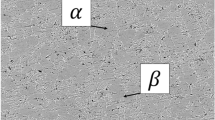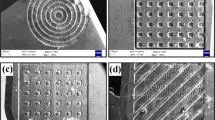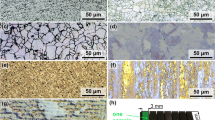Abstract
High-speed milling tests were carried out on Ti–6Al–4V titanium alloy with a polycrystalline diamond (PCD) tool. Tool wear morphologies were observed and examined with a digital microscope. The main tool failure mechanisms were discussed and analyzed utilizing scanning electron microscope, and the element distribution of the failed tool surface was detected using energy dispersive spectroscopy. Results showed that tool flank wear rate increased with the increase in cutting speed. The PCD tool is suitable for machining of Ti–6Al–4V titanium alloy with a cutting speed around 250 m/min. The PCD tool exhibited relatively serious chipping and spalling at cutting speed higher than 375 m/min, within further increasing of the cutting speed the flank wear and breakage increased greatly as a result of the enhanced thermal–mechanical impacts. In addition, the PCD tool could hardly work at cutting speed of 1,000 m/min due to the catastrophic fracture of the cutting edge and intense flank wear. There was evidence of workpiece material adhesion on the tool rake face and flank face in very close proximity to the cutting edge rather than on the chipped or flaked surface, which thereby leads to the accelerating flank wear. The failure mechanisms of PCD tool in high-speed wet milling of Ti–6Al–4V titanium alloy were mainly premature breakage and synergistic interaction among adhesive wear and abrasive wear.
Similar content being viewed by others
References
Ezugwu EO, Wang ZM (1997) Titanium alloys and their machinability—a review. J Mater Process Technol 68(3):262–274
Ezugwu EO, Bonney J, Yamane Y (2003) An overview of the machinability of aeroengine alloys. J Mater Process Technol 134(2):233–253
Li R, Shih AJ (2006) Finite element modeling of 3D turning of titanium. Int J Adv Manuf Technol 29(3–4):253–261
Li AH, Zhao J, Zhou YH, Chen XX, Wang D (2012) Experimental investigation on chip morphologies in high-speed dry milling of titanium alloy Ti–6Al–4V. Int J Adv Manuf Technol 62(9–12):933–942
Li AH, Zhao J, Luo HB, Zheng W (2011) Machined surface analysis in high-speed dry milling of Ti–6Al–4V alloy with coated carbide inserts. Adv Mater Res 325:412–417
Li AH, Zhao J, Luo HB, Pei ZQ, Wang ZM (2012) Progressive tool failure in high-speed dry milling of Ti–6Al–4V alloy with coated carbide tools. Int J Adv Manuf Technol 58(5–8):465–478
Li AH, Zhao J, Luo HB, Pei ZQ (2012) Wear mechanisms of coated carbide tools in high-speed dry milling of titanium alloy. Tribology 32(1):40–46
Jawaid A, Sharif S, Koksal S (2000) Evaluation of wear mechanisms of coated carbide tools when face milling titanium alloy. J Mater Process Technol 99(1–3):266–274
De Melo ACA, Milan JCG, Da Silva MD, Machado AR (2006) Some observation on wear and damages in cemented carbide tools. J Braz Soc Mech Sci Eng 28(3):269–277
Deng JX, Li YS, Song WL (2008) Diffusion wear in dry cutting of Ti–6Al–4V with WC/Co carbide tools. Wear 265(11–12):1776–1783
Wu Z, Deng JX, Chen Y, Xing YQ, Zhao J (2012) Performance of the self-lubricating textured tools in dry cutting of Ti–6Al–4V. Int J Adv Manuf Technol 62(9–12):943–951
Corduan N, Himbart T, Poulachon G, Dessoly M, Lambertin M, Vigneau J, Payoux B (2003) Wear mechanisms of new tool materials for Ti–6AI–4V high performance machining. CIRP Ann Manuf Technol 52(1):73–76
Li AH, Zhao J, Wang D, Gao XL, Tang HW (2013) Three-point bending fatigue behavior of WC–Co cemented carbides. Mater Des 45:271–278
Nurul Amin AKM, Ismail AF, Nor Khairusshima MK (2007) Effectiveness of uncoated WC–Co and PCD inserts in end milling of titanium alloy—Ti–6Al–4V. J Mater Process Technol 192–193:147–158
Heath PJ (2001) Developments in applications of PCD tooling. J Mater Process Technol 116(1):31–38
Nabhani F (2001) Wear mechanisms of ultra-hard cutting tools materials. J Mater Process Technol 115(3):402–412
Oosthuizen GA, Akdogan G, Treurnicht N (2011) The performance of PCD tools in high-speed milling of Ti6Al4V. Int J Adv Manuf Technol 52(9–12):929–935
Author information
Authors and Affiliations
Corresponding author
Rights and permissions
About this article
Cite this article
Li, A., Zhao, J., Wang, D. et al. Failure mechanisms of a PCD tool in high-speed face milling of Ti–6Al–4V alloy. Int J Adv Manuf Technol 67, 1959–1966 (2013). https://doi.org/10.1007/s00170-012-4622-1
Received:
Accepted:
Published:
Issue Date:
DOI: https://doi.org/10.1007/s00170-012-4622-1




